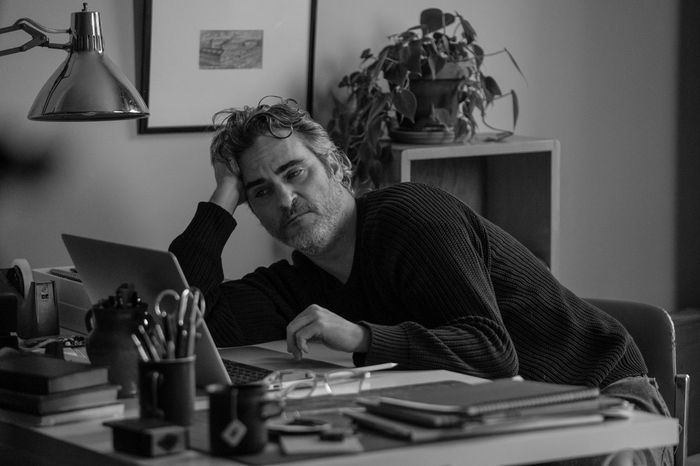
“When you think of the future, what do you imagine it’ll be?” Johnny (Joaquin Phoenix) asks kids of various backgrounds, races, genders, and geographic origins as part of a murkily defined NPR-esque podcast package he’s spearheading. The project is the backbone of writer-director Mike Mills’s latest tenderhearted film, C’mon C’mon, detailing the complications of cross-generational dynamics in black-and-white. The answers to his question run the gamut. The kids speak about fears of climate change and the earth tipping into fiery oblivion; they discuss familial complications and the ways adults don’t listen; they touch on loneliness and loss. Their responses give the film an expansive quality — morally, intellectually, emotionally — that is grounded by the single family at its center: Johnny nurtures his 9-year-old nephew, Jesse (Woody Norman), taking him from his home in Los Angeles to the different cities he visits for work, while his novelist sister, Viv (Gabby Hoffman), helps Jesse’s father Paul (Scoot McNairy) during a manic bipolar disorder episode in the Bay Area.
Not much happens in C’mon C’mon. There’s no overly grand gestures of love. There’s no arch monologues. There’s no teary reappraisals underscored by irrevocable shifts in the characters’ lives. As Johnny travels with Jesse in tow and Viv wrestles with Paul’s refusal to heal in the linear fashion people who don’t struggle with mental illness expect, the film finds a raw beauty in the wonders and heartbreaks of everyday life. It’s a humble portrait of a family’s deepening connections supported by a number of cinematic pleasures — expert sound design and cinematography; touching performances by Norman and Hoffman; and a tremendous showing from Joaquin Phoenix, operating at a register he’s rarely found before. It’s a career best for him — lovely, empathetic, humane.
Black-and-white cinematography can have multiple effects. It can place audiences in another time. It can render a story like a fable. Here, thanks to cinematographer Robbie Ryan, everything is softened and enshrined: the deep shadows of a bedroom cut by the light turned on by a child; the velvety darkness of a bustling New York City night; bodies in motion, swamped in delight and regret. There’s a particular composition I can’t get out of my head: Viv and Johnny are arguing in flashback about their deteriorating mother (Deborah Strang) beset by dementia. He coddles her, giving into the machinations of a parent who cherished him but never understood his sister, and Viv admonishes him for it. The doorway to the room they’re arguing in acts as a frame within the frame, and within that second frame, we see Viv sitting down, her body guiding our eyes to Johnny, who is seen in a mirror. Johnny is a reflection while Viv is in the flesh; family struggles are a hall of mirrors.
Conversations bleed from one scene to another. A hushed phone call opens up the world of a flashback; there are transitions from diegetic to non-diegetic sound. Jesse, with exuberant curiosity, wears Johnny’s recording equipment on his already slight frame to document the noises of the world around him. (As Johnny says to Jesse, recording allows us to make a mundane thing immortal.) On Venice Beach, ocean waves and wheels hitting pavement fill his ears. In New York City, the rumble of the train and the slick movements of skateboarders grab his attention. I am extremely partial to the New Orleans segment of the film that closes Johnny and Jesse’s peripatetic journey. The city feels so alive — a parade of costumed folks bending glamour to their will, the thrum of music and voices crackling in the air — I ached to be transported to the film’s vision of it all, where people’s hearts are open. The editing by Jennifer Vecchiarello is key to the rhythm of the film’s sights and sounds, like in that hushed phone-call flashback: Viv is driving in the car when Johnny’s voice comes on the radio, but Jesse, in the back seat, doesn’t recognize his uncle’s voice. It’s a moment among many that cues us to the chasm Johnny and Viv are trying to bridge.
Mills’s work has always explored generational connections within families — both found and born into — including 2010’s Beginners and 2016’s almost-masterpiece 20th Century Women. Mills understands that for many of us, merely thinking of our families can be like pressing a bruise — or worse, like sticking our fingers into a gaping wound. C’mon C’mon nudges at questions like, How do we heal in the face of losing a parent? How is love worth the pain of losing it? The film uses the growing relationship between Johnny and Jesse most profoundly, as the former tries desperately to connect and the latter prods him the way only a blunt child can. Jesse is precocious, needy to the point of annoying, a dynamic Norman expertly brings out. (“I mostly hang out with adults,” Jesse tells Johnny.) Notably, he is aware of what’s going on with his father and worries such a future could be his fate.
If there is one critique I’ll level at Mills’s film, it’s how Jesse’s father is handled. I’m currently diagnosed as bipolar type II. I’ve always been unsure about having kids out of fear of what I would pass down — generational trauma, anger, body-image issues, an anxiety that sets me on edge in new places, the mental illness that has disrupted and reshaped my life over and over again since I was 13 years old. If you deal with mental illness yourself, you start to notice some patterns in movies and TV shows that attempt to address it. There are times when the experiences of the person mired in illness are downplayed in favor of showing how that person warps the lives of the people around them. In C’mon C’mon, we never get to hear Paul’s own perspective on his illness, or even hear his voice much at all beyond moments with Viv in his apartment as he’s preparing to be admitted into a mental hospital, framed by a phone conversation with Johnny. McNairy’s performance can’t help but tilt dangerously close to spectacle without the interiority to flesh it out.
But Mills’s story is not about Paul. And it’s not necessarily about Viv, either, though she could easily be the center of her own film. C’mon C’mon quotes from Mothers: An Essay on Love and Cruelty by Jacqueline Rose: “Mothers cannot help but be in touch with the most difficult aspects of any fully lived life. Along with the passion and pleasure, it is the secret knowledge they share. Why on earth should it fall to them to paint things bright and innocent and safe?” And Hoffman, aware of the burdens her character carries, is a strong match for Phoenix in the part — at first tentative, then full tilt open. But even then, the film is undeniably Phoenix’s.
The 47-year-old actor, who has been a performer since childhood in the early 1980s, has had an increasingly dynamic career. In 2012’s tricky masterpiece The Master and 2017’s violent You Were Never Really Here, he plays brutal and broken. In 2014’s Inherent Vice, he has the makings of a stoner icon; his performance has a hazy, bouncy quality. In others, like 2013’s Her, he gives his character an undeniable yearning. His physicality has been both guarded and wild. In 2019’s Joker, which earned him an Oscar, Phoenix is at his most ostentatious, his emaciated frame acting out sharp movements and facial expressions. It is the polar opposite of his performance in C’mon C’mon. Here, Phoenix is mellow. He possesses a warmth that glows from beginning to end. As Johnny, Phoenix listens to people and the world around him with full-bodied curiosity. This is where the bravura lies in the performance: his ability to seemingly just be.
C’mon C’mon is a testament to Phoenix’s hard-won talents and ability to ever level up as a performer, but it is bolstered by everything around it. With all its softness and sweetness, the story never tips into being saccharine. It’s the kind of movie we don’t get often in Hollywood — one that turns the camera on everyday life, on getting by and connecting and surviving until the next day and the next and the next.
More Movie Reviews
- Guy Ritchie Goes Brutally Posh
- Dune: Part Two Is Zendaya’s Movie
- Drive-Away Dolls Is Just Fizzy Enough





